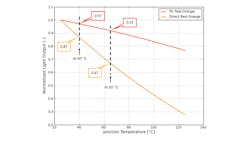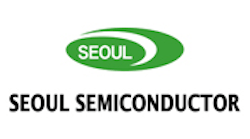Lumileds has announced a new Luxeon 7070 (7×7-mm) LED that is based on a lead frame and plastic package, yet that is intended to target high-performing, ceramic, high-power LEDs in applications such as street lights and sports-venue lighting. In addition, developers working on color solid-state lighting (SSL) systems continue to get more options in their tool chest including a Lumileds phosphor-converted, PC Red-Orange LED. In a business and branding deal, Seoul Semiconductor has announced that it has fully acquired all intellectual property (IP) and branding rights to SunLike LEDs that were originally a joint development with Toshiba Materials supplying the phosphor mix.
Mid-power technique, high-power result
Lumileds was arguably the first of the LED manufacturers to realize that a lead-frame-based design could ultimately perform reliably in what had been the domain of high-power, ceramic packages. Back in 2014, the company created what it called mid-power March, and over a month made a series of announcements on new LEDs packaged in advanced plastics and brought its hot color binning/targeting to mid-power LEDs. Two years later, March brough another series of announcements in the mid-power sector including a component in a silicon molding compound (SMC) package that squarely targeted high-power LED opportunities.
Now, however, Lumileds is targeting the most demanding applications in SSL including the aforementioned outdoor applications and also horticultural lighting and high-bay lighting. Lumileds says the Luxeon 7070 LED will deliver significant system-level cost reductions while also delivering on quality and reliability requirements in the demanding target applications.
Lumileds says the new LED delivers three times the lumen output of the Luxeon 5050 LEDs and those components were considered significant advancements in the lead-frame space. At nominal drive currents, the LEDs deliver around 1500 lm but can be driven at higher levels , reaching more than 2000 lm. The 7070 LEDs use a large array of blue pumps, have a 12V forward voltage that can marginally improve driver efficiency, and each LED works with off-the-shelf thermal and optical components that are stocked immediately by Future Lighting Solutions.
“Across seven critical parameters, lumens per emitter, lumens per watt, lumens per dollar, system cost, optical compatibility, ruggedness, and lumen maintenance, Luxeon 7070 is the clear best overall value for new designs,” said Noman Rangwala, product line director at Lumileds. “We’ve worked in advance with Future Lighting Solutions, LEDiL, and Carclo to develop asymmetric and symmetric optical systems available at launch so that manufacturers can immediately take advantage of Luxeon 7070’s power and robustness.”
Lumileds said the LEDs have undergone 6000 hours of LM-80 testing and L90 ratings are in the 100,000-hr range for 65°C operation. Moreover, as the LED component costs continue to fall, the larger arrays make more sense in terms of system-level lm/$. Lumileds compared similarly performing systems with 3030, 5050, and the new 7070 LEDs. The lm/$ figure of merit dropped from 2.20 to 2.06, to 1.53. Moreover, SSL product developers can trade off over-driving the LEDs and settling for lower efficacy or under-driving the components to maximize efficacy.
Color LEDs
A few days prior to the Luxeon 7070 launch, the company also made the addition in the Luxeon 2835 Color Line of the PC Red-Orange LED that as the prefix suggests is phosphor converted and not monochromatic. That 2835 line has quite a few colors available already and some are also available in phosphor-converted options such as PC Amber or monochromatic Amber. The 2835 portfolio already included a monochromatic Red-Orange. We have explained previously that there could be advantages to either approach such as the width of the spectral band in the region.
In the case of the Red-Orange LEDs, Lumileds said the PC version delivers a significant advantage in total output. The PC technology can also unify optical height and make LED lifetime consistent across colors as all use the same basic foundational LED. And who can argue with more color options.
“Illumination possibilities are driven, in part, with color, and the more colors that are available, the more exciting, interesting, engaging, or comfortable lighting can be,” said product manager LP Liew. “From architectural lighting to landscape lighting, pool lighting, emergency vehicle lighting, and even general illumination, we continue to see increased interest and demand for an expanding palate of color options.”
Securing the brand
Moving to the Seoul Semiconductor news, most people in the SSL sector probably associate SunLike with Seoul. The company started a trend in spectral engineering meant to move LED sources to perform nearer the uniform spectral power distribution of the sun. But if you look back to our coverage of the SunLike launch in 2017, our headline makes it clear that we were writing about a joint announcement made by Seoul Semiconductor and Toshiba Materials.
At that point in time, Toshiba had discontinued its packaged LED program. But clearly the Toshiba Materials business had optimized a three-phosphor approach for light quality whereas most white LEDs at the time used two phosphors. Seoul developed a violet, or what it called at the time a purple, LED or pump as the basis for the LED.
Seoul hasn’t revealed the business arrangement that has existed with Toshiba relative to SunLike. But now Seoul will own all rights. The company does not have plans to license the SunLike phosphor to other competitors. But by fully acquiring the IP and branding rights, Seoul will have full control in allowing its customers to use the SunLike brand. Moreover, Seoul will control forward advancements in the technology and have more freedom to improve and diversify the portfolio.
LEDs Magazine chief editor MAURY WRIGHT is an electronics engineer turned technology journalist, who has focused specifically on the LED & Lighting industry for the past decade.
For up-to-the-minute LED and SSL updates, why not follow us on Twitter? You’ll find curated content and commentary, as well as information on industry events, webcasts, and surveys on our LinkedIn Company Page and our Facebook page.







